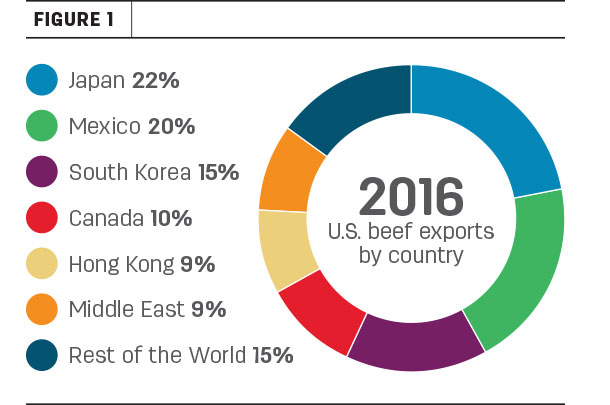When it comes right down to it, global trade is incredibly important for many of our agricultural commodities, including beef. Often, the markets can live or die by what happens in the trade arena. Here are a few things that you need to know about the importance of trade to the U.S. beef industry.
1. The U.S. is the top beef producer and consumer in the world
In 2016, the U.S. produced 11.4 million metric tons of beef and veal, and is projected to produce 11.8 million metric tons of beef in 2017 according to the USDA’s Foreign Agricultural Service (FAS). Brazil is the second largest beef producer with 9.2 million metric tons of production, followed closely by the European Union with 7.8 million metric tons. The U.S. is also the world’s largest consumer of beef, consuming 11.7 million metric tons in 2016, which is more than we currently produce.
2. The U.S. is the fourth largest beef exporter in the world
According to FAS, the U.S. exported about 1.1 million metric tons of beef in 2016, trailing only Brazil, India and Australia. While we consume more total beef than we produce, the U.S. beef industry specializes in producing more expensive, high-quality cuts of beef. As a result, we produce more steak and high-quality cuts of meat than we can consume. These high-quality cuts of beef, as well as many variety meats such as tongue and heart that U.S. consumers tend to shy away from, make up a substantial portion of U.S. beef exports.

3. The U.S. is the largest beef importer in the world
The U.S. imported nearly 1.4 million metric tons of beef from around the world, making it the largest beef importer by a large margin. China is the second largest beef importer in the world with 825,000 metric tons of beef imported, according to FAS. Although the U.S. is the largest beef producer in the world, as mentioned above, we specialize in producing high-quality cuts of beef. However, the production of ground beef in the U.S. cannot keep pace with ground beef demand.
Much of the grain-fed beef produced in the U.S. has too high of a fat content to go directly into ground beef. Instead, grain-fed beef is typically mixed with lean beef to reduce fat content. Some of this lean beef comes from slaughter cattle and bulls, but there is still not enough to make up the difference. This is where imported beef becomes important. While we specialize in high-quality, grain-fed beef, other countries such as Australia, New Zealand, and South America specialize in grass-finished cattle. This lean, grass-fed beef is exactly what we need to mix with our ground beef to meet our consumer demand.
4. Japan is the largest importer of U.S. beef
Japan imported nearly 259,000 metric tons of U.S. beef in 2016, giving them a slight advantage over Mexico as the largest destination for U.S. beef exports. However, 2016 may be more of an anomaly for Japanese demand for U.S. beef. Japan typically gets more of its beef imports from Australia, but due to drought and high prices, Australian beef exports fell by nearly 500,000 metric tons, or 33 percent, between 2015 and 2016. At the same time, the U.S. saw cattle prices drop, which has given us an advantage in the Japanese market, although that advantage could be short-lived due to Australia’s advantage with regards to lower tariffs into the Japanese market.
5. Thirty percent of U.S. beef exports stay in North America
In 2016, the U.S. exported 242,000 metric tons of beef to Mexico and 116,000 metric tons of beef to Canada, comprising of just over 30 percent of all U.S. beef exports. A big driver behind the free flow of beef to and from Canada and Mexico is a direct result of NAFTA. NAFTA allows the U.S. to export and import beef as well as live cattle to and from Canada and Mexico virtually free of tariffs or any other trade barriers.
On top of the beef that is exported to our neighbors to the north and to the south, we also imported nearly 2 million head of cattle from Mexico and Canada in 2015. While some of those cattle went directly to slaughter, many of them were going to U.S. feedlots. In fact, as the U.S. herd size was contracting a few years ago, many feedlots relied on Mexican feeder cattle to fill their pens. Many of those cattle were fattened in U.S. feedlots, went to U.S. packing plants and eventually came full circle when the beef was exported back to Mexico. ![]()

-
Brian Williams
- Assistant Extension Professor
- Mississippi State University
- Email Brian Williams
PHOTO: Photo courtesy of Thinkstock.








